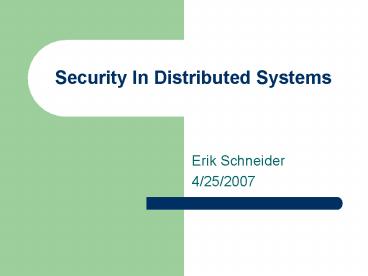Security In Distributed Systems PowerPoint PPT Presentation
1 / 24
Title: Security In Distributed Systems
1
Security In Distributed Systems
- Erik Schneider
- 4/25/2007
2
What is a Distributed System?
- Description
- Architectures
- Client / Server
- Distributed Object
- Peer to peer
- Service Oriented
3
Client / Server Architecture
- Thin Client vs. Fat Client
- Tiered Architecture
4
Distributed Object Architecture
5
Peer-to-Peer Architecture
- Examples
- Napster
- Gnutella
- Computations may be carried out by any node in
the network - Links between any two nodes that are know to each
other
6
Service Oriented Architecture
- Loosely coupled services on a network
- Smaller, more compact applications
- Reactive and adaptive applications
7
What is Security?
- Integrity
- Authentication
- Authorization
- Confidentiality
- Non-repudiation
8
Who to be afraid of?
- Everyone!
9
Security Threats
- Packet Sniffing
- Replay Attack
- Masquerade Attack
- Denial of Service
- Malicious Code
10
Authentication
- Passwords
- Password Salting
- Challenge / Response
- One-time passwords
- Biometrics
- Digital Certificates
11
Authorization
- Access Control Lists
- Capabilities
- Application Level
12
Access Control Lists
- List of permission attached to an object
- Categories
- Discretionary
- Mandatory
- Role based
- Convenience
13
Capabilities
- Tokens
- Shared between processes
- Possession grants permission
- Like file descriptors
- Confused Deputy Problem
14
Application Level
- Be Creative
15
Confidentiality
- Encryption
- Public Key
- Private Key
- Protocols
- TSL
- HTTPS
16
Public Key Encryption
- AKA Asymmetric cryptography
- Pair of keys, public and private
- Locked mailbox with a mail slot analogy
- Authentication of public keys
- PKI, PGP
- Computationally intensive
17
Private Key Encryption
- AKA Symmetric key algorithm
- Algorithm Types
- Stream Ciphers
- Block Ciphers
- Less computationally intensive than public key
- Have to keep both keys a secret on both ends
unless its useless - Difficult key management
18
TSL
- Cryptographic protocol for secure communication
- Endpoint authentication
- Public key-based key exchange and
certificate-based authentication - Symmetric cipher-based traffic encryption
- Handshaking
19
HTTPS
- Secure HTTP connection
- Combination of HTTP and TSL
- Prevent eavesdropping
20
Non-repudiation
- Digital Signatures
- Message Transfer Agents
- Third party for proof
21
Digital Signatures
- Type of asymmetric cryptography
- Sealing of an envelope analogy
- Used for Public Key Infrastructure
- Consists of three algorithms
- Key generation
- Signing
- Signature verification
- Benefits
- Authentication
- Integrity
22
Technologies
- DCE
- Kerberos
- Active Directory
23
Questions
- ?
24
References
- Bruce, Glen Dempsey, Rob Security in Distributed
Computing. Hewlett-Packard Co 1997 - Tanenbaum, Andrew Modern Operating Systems.
Prentice-Hall 2006 - Sommerville, Ian Software Engineering. 2004
- http//en.wikipedia.org/wiki/Computer_security
- http//en.wikipedia.org/wiki/Encryption
- http//www.nihilent.com/white_papers/information_s
ecurity_attacks.pdf

